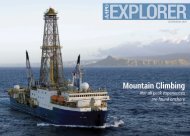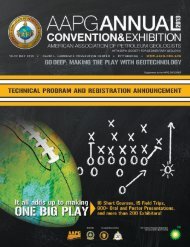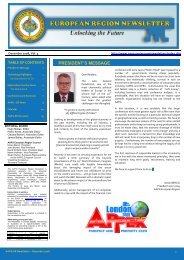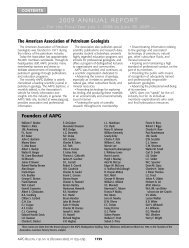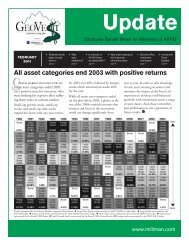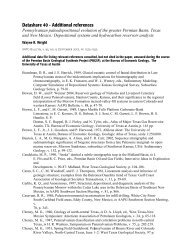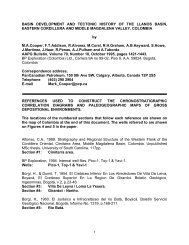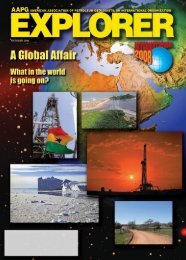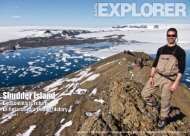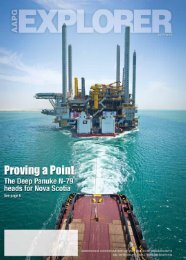AAPG Explorer - June 2010 - American Association of Petroleum ...
AAPG Explorer - June 2010 - American Association of Petroleum ...
AAPG Explorer - June 2010 - American Association of Petroleum ...
You also want an ePaper? Increase the reach of your titles
YUMPU automatically turns print PDFs into web optimized ePapers that Google loves.
French Team Takes Top Honors in <strong>2010</strong> IBA<br />
Graduate students representing the<br />
Institut Francais du Petrole took<br />
the top prize in this year’s Imperial<br />
Barrel Awards competition, beating<br />
out 11 other teams from geology and<br />
geophysical departments from around<br />
the world.<br />
The finals were held in New Orleans<br />
right before the start <strong>of</strong> the <strong>AAPG</strong><br />
Annual Convention and Exhibition.<br />
The IFP win marked the second<br />
consecutive year that a team<br />
representing <strong>AAPG</strong>’s European Region<br />
claimed first place in the global<br />
competition, which carries individual<br />
medals and a $20,000 prize for their<br />
petroleum geoscience department.<br />
Members <strong>of</strong> the IBA winning team<br />
are Matthieu Bregeaut, Jeanne Pelé,<br />
Francys Espaillat, Herman Rojas and<br />
Shiladitya Sengupta. The faculty adviser<br />
is Anne Duhem Jardin.<br />
Finishing second (Selley Cup<br />
winners) was the team from the<br />
University <strong>of</strong> Calgary, representing<br />
the Canada Region, which earned<br />
individual medals and $10,000 in<br />
scholarship funds for the department.<br />
Finishing third (Stoneley Medal<br />
winners) was King Fahd University,<br />
representing the Middle East Region,<br />
which earned individual medals and<br />
$5,000 in scholarship funds for their<br />
department.<br />
The remaining nine finalists each<br />
earned $1,000 in scholarship funds for<br />
their respective schools plus individual<br />
medals for themselves as IBA finals<br />
participants. The finals teams were<br />
<strong>AAPG</strong><br />
(alphabetical order):<br />
u Africa Region – Obafemi Awolowo<br />
University, Ile-Ife, Nigeria.<br />
u Asia-Pacific Region – China<br />
University <strong>of</strong> <strong>Petroleum</strong>, Beijing.<br />
u Latin America – EAFIT University,<br />
School <strong>of</strong> Geology, Medellin, Colombia.<br />
u Eastern Section – West Virginia<br />
University, Morgantown, W.Va.<br />
u Gulf Coast Section – University <strong>of</strong><br />
EXPLORER<br />
Louisiana-Lafayette.<br />
u Mid-Continent Section – Oklahoma<br />
State University, Stillwater, Okla.<br />
u Pacific Section – San Diego State<br />
University, San Diego.<br />
u Rocky Mountain Section – Colorado<br />
School <strong>of</strong> Mines, Golden, Colo.<br />
u Southwest Section – University <strong>of</strong><br />
Texas-El Paso.<br />
The IBA program gives teams <strong>of</strong><br />
students the chance to evaluate the<br />
petroleum potential <strong>of</strong> a sedimentary<br />
basin and to test their creative<br />
geological interpretations. Their work<br />
must be completed in a six-to-eight<br />
week period, with results presented to –<br />
and judged by – an independent panel<br />
<strong>of</strong> petroleum industry experts.<br />
A total <strong>of</strong> 57 teams from 18 countries<br />
competed in this year’s IBA program.<br />
Past IBA winners were teams from:<br />
u 2009 – Moscow (Russia) State<br />
University, Moscow, Russia.<br />
u 2008 – The University <strong>of</strong> Oklahoma,<br />
Norman, Okla.<br />
u 2007 – The University <strong>of</strong> Aberdeen,<br />
Scotland.<br />
For more information on the IBA<br />
program go online to www.aapg.org/iba.<br />
Truths’ turned upside down<br />
Unconventional Thought: Get Out <strong>of</strong> the ‘Zone’<br />
By SUSAN R. EATON, EXPLORER Correspondent<br />
Bobby Ryan, vice president <strong>of</strong><br />
Global Exploration for Chevron<br />
Global Upstream Oil and Gas,<br />
challenged <strong>AAPG</strong>’s members to choose<br />
the “unconventional” route forward,<br />
relying upon creativity – coupled<br />
with technological advances – to<br />
fundamentally change the way they<br />
view geological plays.<br />
Ryan, an <strong>AAPG</strong> member and<br />
chairman <strong>of</strong> <strong>AAPG</strong>’s Corporate Advisory<br />
Board, drew on his experience <strong>of</strong><br />
more than 30 years in the oil and gas<br />
industry to deliver a thought-provoking<br />
presentation at the All-Convention<br />
Luncheon in New Orleans titled<br />
“Beyond Zone Six: The Imperative <strong>of</strong><br />
Unconventional Thinking.”<br />
Citing the innovative design and<br />
construction <strong>of</strong> the Golden Gate<br />
Bridge – completed in 1937, it was<br />
the longest span bridge in the world<br />
and held that honor until 1964 – Ryan<br />
challenged <strong>AAPG</strong>’s members to think<br />
the impossible, to “build the bridge that<br />
could not be built.”<br />
Ryan’s presentation on the<br />
imperatives <strong>of</strong> unconventional thinking<br />
set the tone for the <strong>2010</strong> Annual<br />
Convention & Exhibition in New Orleans,<br />
and left many geologists saying: “What<br />
if?”<br />
“As explorationists, we <strong>of</strong>ten get<br />
framed by things beyond our everyday<br />
control – conventional thinking in these<br />
areas holds us back,” said Ryan, a<br />
petroleum geologist by training and<br />
career experience. Those things, he<br />
said, include technology, economics,<br />
the environment, and public and<br />
corporate policy.<br />
“Many people view Zone Six as a<br />
depositional environment, a limit,” he<br />
said. “Actually, one might say that Zone<br />
Six is a state <strong>of</strong> mind ... How do we<br />
move beyond that?”<br />
Defined in geological terms, Zone Six<br />
sits seaward <strong>of</strong> the continental shelf – in<br />
the lower slope to lower bathyal regions<br />
– in water depths ranging between<br />
1,500 to 6,000 feet. In 1979 when Ryan<br />
started his career with Texaco in New<br />
Orleans, the commonly held industry<br />
belief was there were no commercial<br />
prospects in waters deeper than 600<br />
feet, and there were no sands – thus no<br />
reservoirs – in Zone Six.<br />
For decades, these hard-and-fast<br />
rules limited creativity, and, accordingly,<br />
oil and gas exploration.<br />
“At Texaco, the term “deep water”<br />
used to be a four-letter word,” Ryan<br />
said.<br />
Earlier in his career Ryan was<br />
assigned to Texaco’s deepwater team,<br />
and was told to “get us back into the<br />
deep water.”<br />
At the time, Ryan’s skeptical<br />
response was: “What did I do wrong?”<br />
Two decades later, Chevron is a<br />
world leader in the Gulf <strong>of</strong> Mexico’s<br />
deepwater exploration and production.<br />
Say What?<br />
In preparation for his address,<br />
Ryan polled exploration colleagues in<br />
Chevron, asking them to list sweeping<br />
changes that they had witnessed during<br />
the past 30 to 40 years – illustrating how<br />
many “truths” have been turned upside<br />
down by unconventional thinking and<br />
technological advances.<br />
To name just a few:<br />
u Big gas, discovered a long<br />
distance from market, has no value.<br />
u There are no reservoirs in deep<br />
water.<br />
u There are no thrust faults in the Gulf<br />
<strong>of</strong> Mexico.<br />
u Color has no place in seismic<br />
displays.<br />
u High angle wells (i.e., greater than<br />
45 degrees) need special corporate<br />
permission.<br />
u Shales are seals and sources, but<br />
not reservoirs.<br />
u When you hit Zone Six, there is no<br />
sand, so shut the well down.<br />
“There was a time deepwater<br />
exploration was called unconventional<br />
– drilling below salt was also called<br />
unconventional,” Ryan said. “Now<br />
it’s the ‘thinking’ that’s being called<br />
unconventional.”<br />
Moving Beyond Zone Six<br />
Acknowledging the obstacles to<br />
moving beyond Zone Six thinking, Ryan<br />
said, “How do you open the door to<br />
allow your teams to be creative and not<br />
stifled? It takes listening.”<br />
Companies, he explained, must<br />
find the unique balance between<br />
business drivers, the bottom line and<br />
the risks <strong>of</strong>ten associated with thinking<br />
unconventionally.<br />
“When we come up with a new<br />
concept or idea, we need to try it,”<br />
he said, and in citing the successful<br />
adoption <strong>of</strong> bright spot theory or<br />
measurement-while-drilling technology,<br />
he added, “Be bold, and give it a shot.”<br />
What quality does Ryan ascribe to<br />
successful outside-<strong>of</strong>-the-box thinkers?<br />
“The one word that comes to mind,”<br />
he said, “is persistence.<br />
“Successful individuals continue<br />
to push their ideas, about why they’re<br />
the right things to do. It can be a long<br />
process,” he cautioned, “but when<br />
you’re confronted by the perception that<br />
something is impossible, don’t quit.”<br />
The world’s oil and gas supplies will<br />
be “coming from the folks in this room,”<br />
he said. “New plays are credited to the<br />
new ways that people think.”<br />
To read more about this subject,<br />
visit the <strong>AAPG</strong> website.<br />
www.aapg.org<br />
WWW.<strong>AAPG</strong>.ORG JUNE <strong>2010</strong><br />
29



